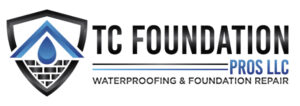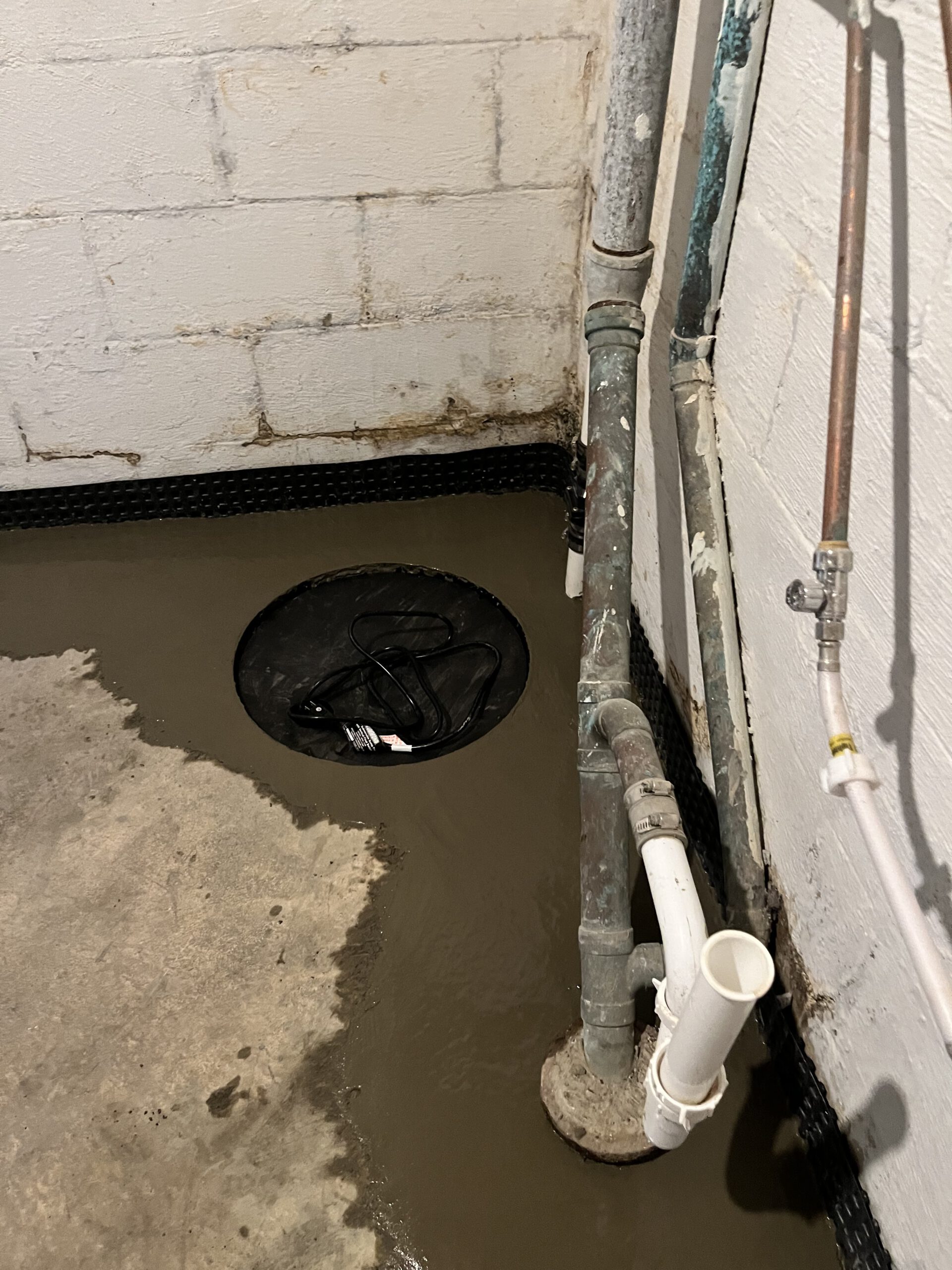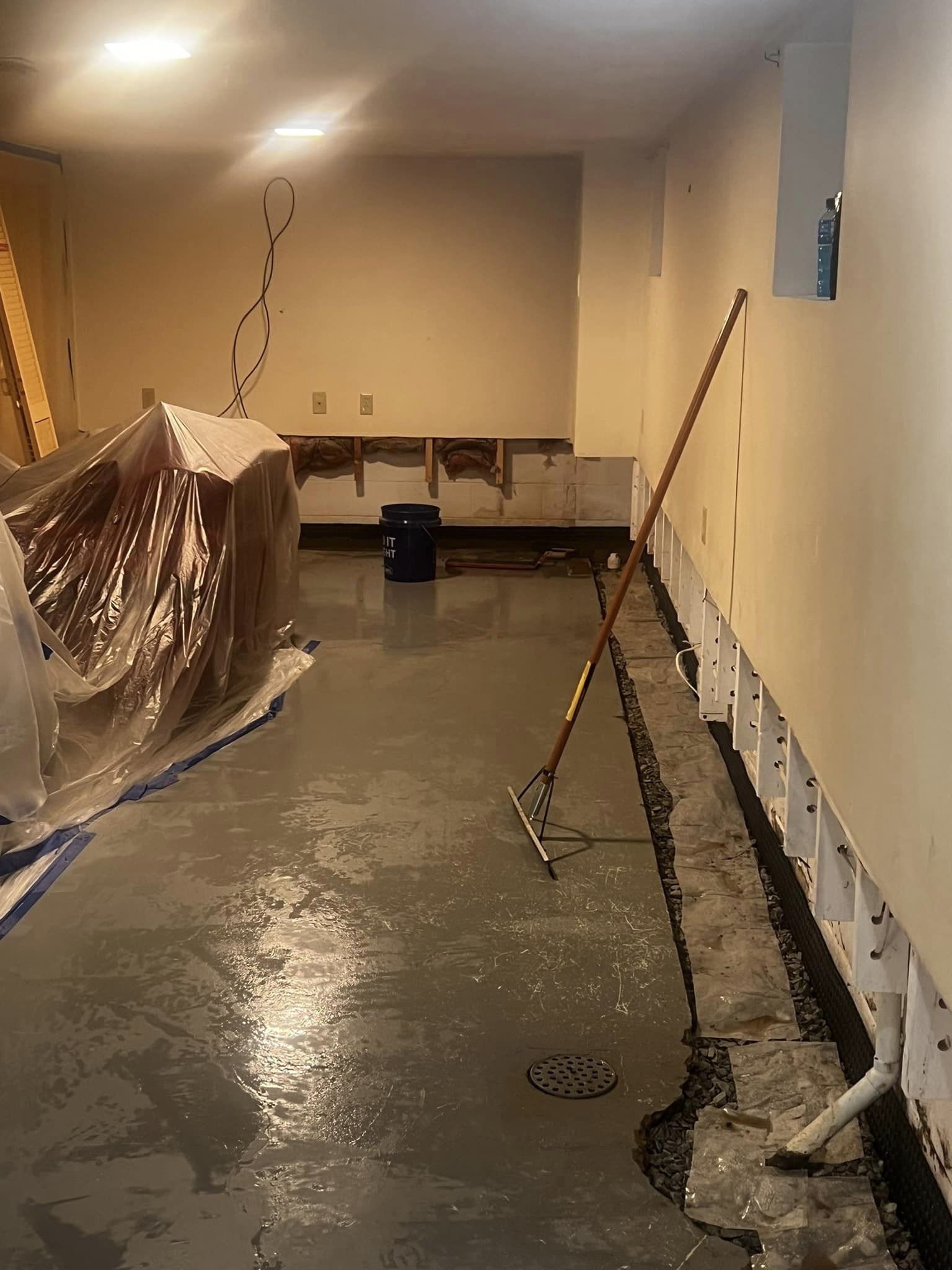Understanding how to effectively waterproof your basement can save you from costly repairs and potential health hazards.
From identifying common causes of leaks to exploring the best waterproofing methods, this extensive guide will equip you with the knowledge and tools needed to protect your basement from water damage.
So, are you ready to guarantee your basement stays dry and secure?
Key Takeaways
- Inspect for cracks, improve drainage, and address mold promptly.
- Use exterior and interior waterproofing methods like membranes, French drains, and sump pumps.
- Regularly maintain sump pumps and consider professional waterproofing for tailored solutions.
- Budget wisely by researching materials, obtaining multiple quotes, and allocating funds effectively.
Common Causes of Basement Leaks
Identify the most common causes of basement leaks by inspecting the foundation for cracks, deteriorated sealants, or poor drainage. Foundation repair is often necessary when cracks allow water to seep into the basement.
Inspect the foundation walls for any visible cracks or gaps, as these can be signs of structural issues that may require professional intervention. Additionally, check the sealants around windows, doors, and utility penetrations. Over time, these sealants can deteriorate, leading to water intrusion. It’s vital to address any deteriorated sealants promptly to prevent further water damage.
Another common cause of basement leaks is poor drainage around the foundation. Make sure that the grading around your home slopes away from the foundation to prevent water from pooling against the walls. Installing a proper drainage system, such as gutters and downspouts, can also help redirect water away from the foundation. Inadequate drainage can lead to water seeping into the basement through the walls or floor.
Moreover, basement insulation plays an important role in preventing leaks. Insulate basement walls to regulate temperature and reduce condensation, which can contribute to moisture issues. Proper insulation can also help prevent water vapor from penetrating the walls and causing damage. Inspect the insulation regularly to ensure it’s in good condition and replace any damaged sections promptly.
Signs of Water Damage
You may notice signs of water damage in your basement through the presence of mold growth and a musty odor. These indicators often suggest excess moisture seepage, which could potentially lead to more severe issues if left unchecked.
Identifying these signs early on can help you promptly address the underlying causes of water damage.
Mold Growth
Detecting mold growth is pivotal in identifying water damage issues in your basement. Mold can be a visible sign of excess moisture, often appearing as black, green, or white patches on walls, ceilings, or floors.
Apart from being unsightly, mold poses significant health risks, such as allergies, respiratory issues, and skin irritation. To prevent mold growth, ensure proper ventilation, control humidity levels, fix leaks promptly, and consider using mold-resistant materials.
Regularly inspect your basement for any signs of mold, especially in dark and damp areas. If you notice mold, it’s essential to address the underlying water damage promptly to prevent further spread and potential health concerns for you and your family.
Musty Odor
To further pinpoint potential water damage issues in your basement, pay attention to the musty odor lingering in the air, as it can be a telling sign of underlying problems. When dealing with a musty basement odor, consider the following:
- Dehumidifier Benefits: Invest in a dehumidifier to reduce moisture levels and prevent musty smells.
- Confirm Proper Ventilation: Verify that your basement has adequate ventilation to keep air circulating and prevent stagnation.
- Moisture Barrier Installation: Install a moisture barrier to block water seepage and reduce humidity levels.
- Flooring Options: Select moisture-resistant flooring materials to prevent water damage and mold growth.
Importance of Proper Drainage
Proper drainage is essential for a successful basement waterproofing in southwestern PA as it effectively directs water away from the foundation. When it comes to addressing water issues in your basement, ensuring proper drainage is a fundamental step in preventing water infiltration and potential damage to your home. Two key elements to think about in achieving effective drainage are grading improvement and the installation of French drains.
Grading Improvement: One of the primary ways to enhance drainage around your home is through grading improvement. This process involves adjusting the slope of the soil surrounding your foundation to make sure that water flows away from the house. By regrading the soil to create a gentle slope away from the foundation, you can prevent water from pooling around the basement walls and seeping into the structure.
French Drains: French drains are another important component of a thorough drainage system. These underground trenches filled with gravel or rock help collect excess water and channel it away from the foundation. By intercepting groundwater before it reaches the basement walls, French drains play an important role in keeping your basement dry and free from moisture-related issues.
Exterior Waterproofing Methods
Improving the exterior waterproofing of your basement involves implementing effective methods to safeguard your home’s foundation from water intrusion. When it comes to exterior waterproofing methods, here are some key strategies to contemplate:
- Exterior Waterproofing Membrane: Applying a waterproof membrane to the exterior walls can create a barrier against water penetration, safeguarding your basement from moisture intrusion.
- Foundation Drainage System: Installing a proper foundation drainage system, such as French drains or footing drains, can help redirect water away from your home’s foundation, preventing water buildup that could lead to leaks.
- Exterior French Drains: These drains are designed to collect water along the exterior of your foundation and direct it away from your home, keeping your basement dry and free from water damage.
- Exterior Beautification: Incorporating landscaping features like sloping the soil away from the foundation, installing gutter extensions, and creating proper grading around your home can enhance its exterior while also aiding in effective water drainage.
Interior Waterproofing Solutions
Consider implementing a reliable interior drainage system to effectively combat water infiltration in your basement. Interior waterproofing techniques play an important role in basement moisture control, ensuring a dry and comfortable living space.
One effective method is installing a French drain, which consists of a perforated pipe surrounded by gravel to collect and redirect water away from the foundation. This system helps alleviate hydrostatic pressure, preventing water from seeping through basement walls and floors.
Another essential interior waterproofing technique is applying a waterproof sealant to basement walls and floors. This sealant creates a barrier that repels water, keeping your basement dry and free from moisture-related issues. Additionally, installing a sump pump can further enhance your interior waterproofing system by efficiently pumping out any accumulated water to prevent flooding.
Proper insulation is also key to controlling basement moisture. Insulating basement walls can help regulate temperature and reduce condensation, ultimately preventing mold and mildew growth. Additionally, ensuring proper ventilation in your basement can aid in moisture control by allowing humid air to escape.
Sump Pump Installation and Maintenance
To guarantee the peak performance of your sump pump system, thorough installation, and regular maintenance are essential. Proper sump pump installation and diligent maintenance will help prevent water damage and keep your basement dry.
Here are some key points to take into account:
- Regular Inspections: Conduct routine checks on your sump pump to make sure it’s in working order and free of any debris that could impede its function.
- Backup Power Source: Install a battery backup or generator to make certain your sump pump continues to operate during power outages, which is critical for preventing flooding.
- Testing Alarms: Regularly test the high water level alarm to make certain it activates correctly in case of pump failure.
- Sump Pump Float: Check the float component of your sump pump regularly to ensure it moves freely and triggers the pump when necessary, avoiding any potential malfunctions.
When it comes to pump maintenance and troubleshooting, understanding the intricacies of your sump pump system is vital. Regularly cleaning and testing your sump pump won’t only extend its lifespan but also provide you with peace of mind knowing your basement is protected. Stay proactive to prevent water issues before they occur.
DIY vs. Professional Waterproofing
DIY solutions may lack the expertise required to address complex basement waterproofing issues effectively. On the other hand, hiring a professional waterproofing contractor offers several benefits that outweigh the initial cost.
Professionals have the experience, training, and specialized equipment necessary to identify the root cause of water infiltration accurately. They can provide tailored solutions that address your basement’s specific needs, ensuring long-lasting protection against moisture intrusion.
Ultimately, while DIY waterproofing may seem like a cost-effective solution, the expertise and guaranteed results provided by professional waterproofing services make them a more reliable choice for ensuring the long-term health and integrity of your basement.
Cost Considerations and Budgeting
When considering basement waterproofing, it’s important to carefully plan your budget to make sure you allocate funds efficiently. Understanding cost-saving strategies can help you make informed decisions to protect your basement without overspending.
Financial considerations such as material costs, labor expenses, and potential long-term savings should all be factored into your budgeting process.
Budgeting Tips for Waterproofing
Consider the cost implications and budgeting strategies when planning for basement waterproofing in Pennsylvania to ensure a successful and financially sustainable project. When budgeting for waterproofing, keep in mind the following tips:
- Research Waterproofing Materials: Explore various options like sealants, membranes, and drainage systems to find cost-effective yet durable solutions.
- Evaluate DIY Techniques: Assess if you can handle certain waterproofing tasks yourself to save on labor costs.
- Get Multiple Quotes: Obtain estimates from different waterproofing contractors to compare prices and services offered.
- Plan for Contingencies: Set aside a buffer in your budget for unexpected expenses that may arise during the waterproofing process.
Cost-Saving Strategies
To maximize cost savings during your basement waterproofing project, carefully assess all expenses and prioritize budgeting strategies for efficient financial management.
When considering waterproofing materials, opt for high-quality products that offer durability and long-term protection to avoid future repair costs. Research different basement sealing techniques such as interior sealants, exterior waterproofing coatings, and drainage systems to determine the most cost-effective solution for your specific needs.
Additionally, compare prices from multiple vendors to get the best deals on materials without compromising on quality. Proper planning and budget allocation for essential waterproofing materials and techniques won’t only save you money in the short term but also prevent costly water damage repairs in the future.
Financial Considerations for Basement Waterproofing
Assess your budget carefully to determine the financial considerations for effectively waterproofing your basement. When planning for basement waterproofing, it’s essential to take into account the financial aspects. Here are some key points to keep in mind:
- Research Financing Options: Explore different financing options available for waterproofing projects.
- Set a Realistic Budget: Establish a detailed budget plan to account for all potential costs involved.
- Consider Long-Term Savings: Investing in quality waterproofing now can save you money on future repairs.
- Get Multiple Quotes: Obtain quotes from several waterproofing companies to compare prices and services offered.
Wrap-Up
Addressing common causes, recognizing signs, ensuring proper drainage, employing exterior methods, implementing interior solutions, maintaining sump pumps, and considering DIY versus professional waterproofing are all essential steps to protect your basement from leaks.
By following these guidelines and staying proactive, you can prevent water damage and maintain a dry, safe basement environment.
Remember, investing in waterproofing now will save you time, money, and headaches in the long run.


